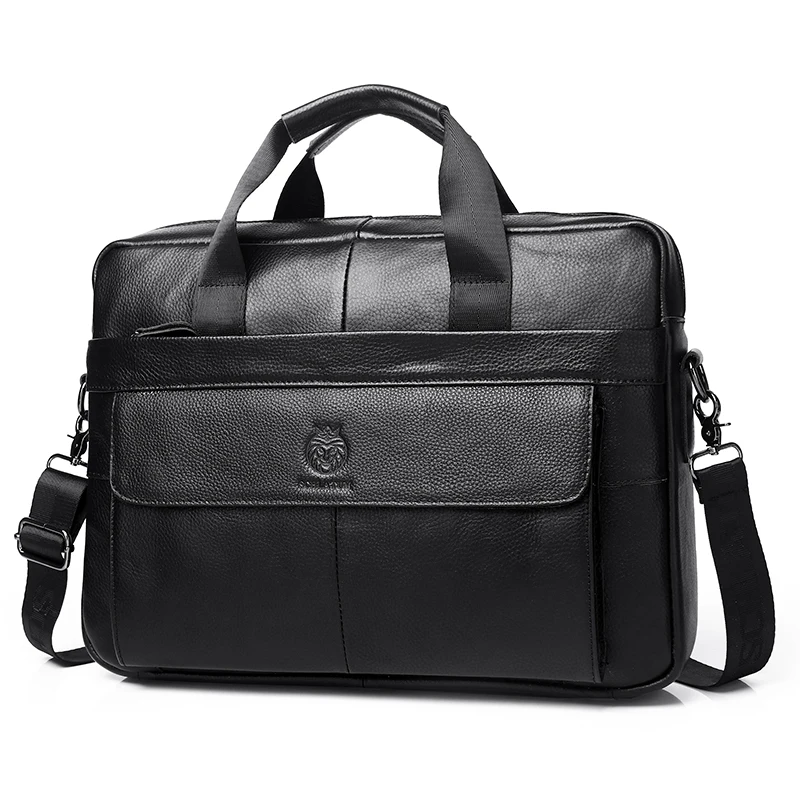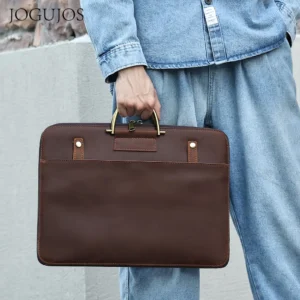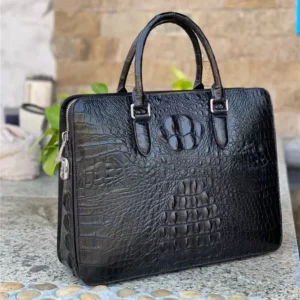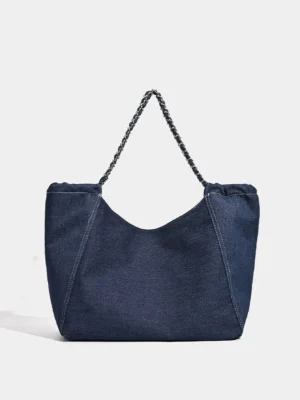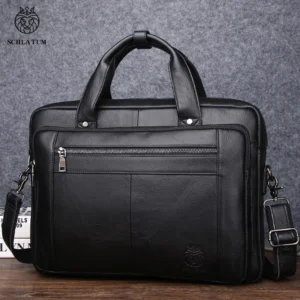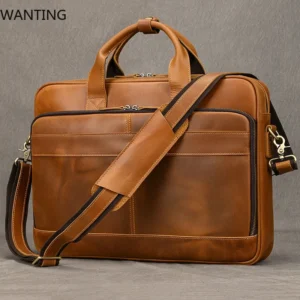Introduction: Why Document Compartments Matter in a Professional Briefcase
In the world of professional accessories, a leather briefcase is much more than a fashion statement—it’s a powerful productivity tool that can transform your workday. The thoughtful organization of documents within your briefcase doesn’t just prevent wrinkled papers; it fundamentally changes how efficiently you operate in professional settings.
The difference between fumbling for an important contract during a client meeting and smoothly retrieving it in seconds lies in how well your briefcase’s internal structure supports your workflow. Proper document organization in leather bags isn’t just about neatness—it’s about leveraging design to enhance your professional capabilities.
Well-designed document compartments provide several key benefits:
- Immediate accessibility to critical papers when time matters most
- Protection against damage, folding, and environmental elements
- Professional presentation that elevates your image in business settings
- Reduced stress and improved focus during important meetings
- Efficient transitions between appointments throughout your day
Imagine standing before a client, desperately searching through a jumbled mass of papers while they wait impatiently. Now contrast that with the confidence of knowing exactly where each document resides, allowing you to maintain your professional composure in any situation. This is the power of thoughtful compartmentalization.
In this comprehensive guide, we’ll explore the world of briefcase organization, from specialized document sections to strategic placement techniques. Whether you’re selecting your first professional briefcase or looking to maximize your current one, understanding the intricacies of leather briefcases and their organizational features will transform how you carry your professional life.
Essential Document Compartment Types: A Complete Breakdown
The interior design of a leather briefcase isn’t arbitrary—each compartment serves a specific purpose in the organizational ecosystem. Different document types require specialized storage solutions to maintain order and accessibility. Understanding these variations helps you select a briefcase with the right internal architecture for your specific needs.
The effectiveness of your bag’s interior layout directly impacts your daily efficiency. Let’s examine the primary document compartment types that define a truly functional professional briefcase:
Accordion File Dividers: Maximum Organization for Multiple Categories
Accordion dividers represent the gold standard for document organization in professional briefcases. These expandable sections feature multiple dividers connected with gusseted material that expands and contracts as needed. This design allows for categorical separation of documents without wasted space.
These structured dividers excel at:
- Maintaining clear separation between different client files
- Organizing documents by project phase or priority level
- Preventing papers from sliding and becoming disorganized during transit
- Protecting documents from bending or folding damage
- Allowing quick visual identification of document categories
Most professional leather document bags feature accordion systems with 3-7 sections, though premium models may offer additional customization. Look for reinforced edges and quality materials at stress points, as these areas face constant handling and pressure.
The accordion system proves particularly valuable for professionals who handle multiple client matters simultaneously or anyone who needs to maintain strict categorization of their paperwork throughout the workday.
Padded Electronic Device Compartments: Protecting Your Digital Documents
As professional workflows increasingly blend digital and physical documents, modern briefcases have evolved to include specialized protection for electronic devices. These compartments safeguard your most valuable digital assets while maintaining harmony with traditional document storage.
A well-designed electronic compartment features:
- Dense foam padding that absorbs impacts and prevents damage
- Strategic positioning for optimal weight distribution within the briefcase
- Microfiber or soft fabric lining to prevent screen scratching
- Secure fastening mechanisms (straps or padding) to prevent shifting during transit
- Appropriate dimensions for standard device sizes (13”, 15”, or 17” laptops)
The most effective briefcases with padded laptop sleeves position these compartments against the back panel, distributing weight evenly against your body while walking and providing maximum protection. Premium models incorporate water-resistant barriers and shock-absorbing materials to protect against everyday hazards.
When evaluating these compartments, ensure they accommodate your specific devices without being excessively large, as too much empty space allows unwanted movement during transit.
Flat Document Sleeves: Simple Access for Frequent Items
Flat document sleeves provide straightforward organization for papers you need to access quickly and frequently. Unlike accordion dividers, these sleeves typically feature a simple slip pocket design without additional dividers or expanding capability.
These sleeves excel at storing:
- Meeting agendas you’ll reference throughout the day
- Presentation materials needed for immediate access
- Travel documents requiring quick retrieval
- Current project briefs or executive summaries
- Frequently referenced reference materials
Look for sleeves constructed with smooth interior materials that allow documents to slide in and out without catching or tearing. Premium briefcases often feature leather-lined sleeves, which provide additional durability while protecting document edges from wear.
The ideal placement for these sleeves is toward the front of the briefcase or in quickly accessible positions that don’t require rearranging other contents.
Zippered Security Pockets: Protecting Confidential Materials
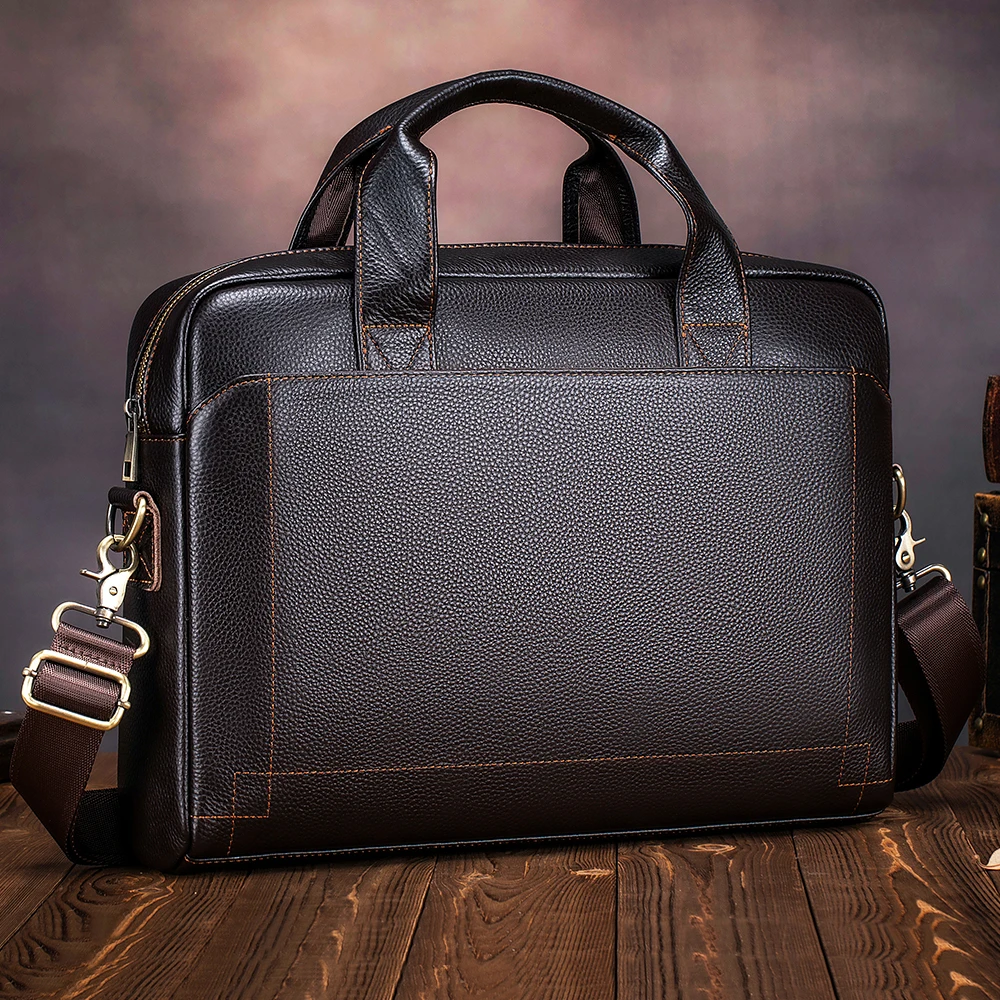
For sensitive documents requiring enhanced security, zippered compartments provide an additional layer of protection and privacy. These secured sections prevent accidental exposure of confidential materials and offer peace of mind during transit.
Key features of quality security pockets include:
- High-grade zippers (YKK or similar) that operate smoothly without catching
- Strategic positioning away from casual view or access
- Interior lining that prevents document edges from snagging
- Reinforced stitching to maintain integrity even when frequently accessed
- Weather-resistant construction to protect sensitive documents
These compartments prove ideal for confidential client information, contracts with sensitive terms, proprietary business plans, or personal financial documents. Premium briefcases sometimes incorporate RFID-blocking technology into these sections, protecting electronic data stored in modern identification and payment cards.
The security of these pockets depends not just on the zipper quality but on the overall construction integrity and placement within the briefcase architecture.
Beyond Documents: Essential Organization for Professional Accessories
A truly comprehensive briefcase organizational system extends beyond document storage to accommodate the various tools and accessories that support your professional activities. These complementary compartments ensure everything from writing instruments to technology accessories remains accessible and protected.
Effective organization of your mobile paperwork depends on having appropriate storage for the tools that interact with those documents. When these elements work in harmony, your briefcase functions as a complete mobile workstation rather than merely a document carrier.
Writing Instrument Organization: Pen Loops and Tool Storage
Quality briefcases incorporate thoughtfully designed storage for writing instruments, recognizing their essential role in professional document workflows. These specialized features prevent damage to both the instruments themselves and surrounding items.
Effective pen organization options include:
- Individual leather loops sized appropriately for standard pens and markers
- Elastic multi-pen holders that accommodate various instrument diameters
- Dedicated pen pockets with protective lining to prevent ink leakage damage
- Segmented tool organizers for pens, highlighters, and styluses
Premium briefcases typically position these features for easy access—often near document compartments where they’ll be used. Look for reinforced stitching around pen loops, as these areas experience frequent stress from insertion and removal.
For professionals who use premium writing instruments, leather loops provide superior protection against scratching compared to elastic alternatives, though they offer less flexibility in accommodating different pen diameters.
Digital Accessory Pockets: Cable Management and Device Support
Modern professionals rely on various electronic accessories that require specialized organization. Contemporary briefcase designs acknowledge this reality with dedicated solutions for cable management, power storage, and connectivity tools.
Effective digital accessory organization features include:
- Elasticized cable organizers that prevent tangling and damage
- Small zippered pockets for USB drives, adapters, and memory cards
- Power bank compartments with cable pass-through capabilities
- Mesh pockets that allow visual identification of small accessories
The best laptop briefcases integrate these features in proximity to electronic device compartments, creating intuitive workflow zones within the briefcase architecture. This thoughtful placement minimizes the need to rearrange contents when connecting devices or accessories.
When evaluating these features, consider both your current and anticipated future technology needs, as professional tech accessories tend to evolve rapidly.
Selecting the Perfect Briefcase: A Compartment-Focused Approach
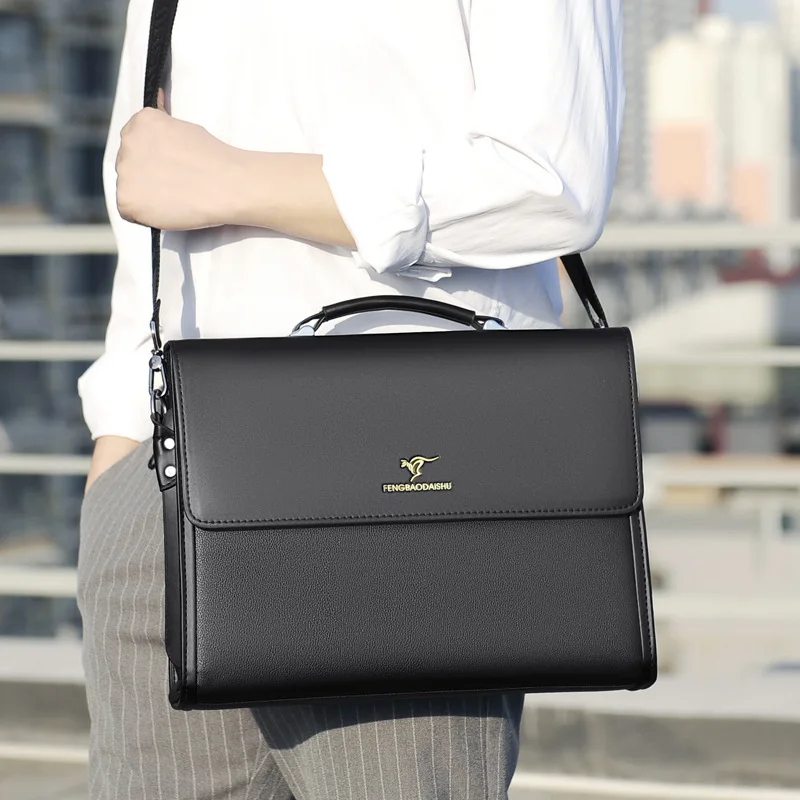
Finding the ideal briefcase requires looking beyond aesthetics to evaluate how its organizational architecture aligns with your specific document needs. This methodical approach ensures your investment delivers daily practical value rather than just visual appeal.
The foundation of this selection process is a thorough assessment of your document carrying requirements—both typical daily needs and occasional maximum loads. This evaluation creates a clear picture of the organizational structure that will best serve your professional life.
Assessing Your Daily Document Needs: Creating Your Carry Profile
Developing a personal “carry profile” allows you to make informed decisions about briefcase organization requirements. This systematic evaluation ensures your selection accommodates both regular and occasional document loads without compromise.
To create your carry profile, consider:
- The average number of distinct document categories you carry daily
- Maximum number of pages typically carried in each category
- Physical dimensions of any non-standard document sizes
- Frequency of electronic device transport alongside physical documents
- Need for secure storage of confidential materials
- Transition frequency between different document sets throughout the day
This assessment reveals your fundamental organizational requirements. For example, an attorney moving between multiple client meetings might need extensive accordion file sections, while a creative professional might prioritize larger flat compartments for portfolios and design samples.
Remember that effective document storage in leather bags should balance capacity against weight and bulk—excessive capacity often leads to unnecessary weight and reduced functionality.
Profession-Specific Considerations: Matching Features to Your Field
Different professions place unique demands on briefcase organization systems. Understanding these specialized requirements helps you prioritize features that directly support your specific workflow and document handling patterns.
Legal professionals typically benefit from:
– Extensive accordion file systems for case separation
– Secure zippered compartments for confidential client information
– Reinforced structure to support heavier document loads
– Business card organization for networking and client management
Financial professionals often require:
– Multiple flat document sleeves for presentation materials
– Secure electronic device storage for financial modeling tools
– Dedicated sections for prospectus and offering documents
– Organization systems for business cards and client contact information
Creative professionals may prioritize:
– Larger flat compartments that accommodate portfolios
– Specialized storage for design tools and technology
– Flexible organization systems that adapt to varying project materials
– Easy-access compartments for frequent presentation needs
When evaluating briefcases, consider how specific organizational features align with your profession’s unique document handling requirements. The men’s classic leather briefcase collection offers various configurations designed to accommodate different professional needs.
Maximizing Efficiency: Strategic Use of Briefcase Compartments
Even the most thoughtfully designed briefcase requires strategic usage to deliver its full organizational potential. Implementing systematic approaches to document placement and maintenance transforms a good briefcase into an exceptional productivity tool.
Effective compartment utilization begins with intentional document placement based on access frequency and workflow patterns. This deliberate approach minimizes searching time and maximizes protection for your most important materials.
Men's Classic Leather Briefcase, Slim Leather Laptop Briefcase, Slim Leather Portfolio Briefcase
$93.67 Select options This product has multiple variants. The options may be chosen on the product pageClassic Laptop Briefcase, Men's Classic Leather Briefcase, Slim Leather Attache Case
Price range: $353.50 through $360.81 Select options This product has multiple variants. The options may be chosen on the product pageBlack Leather Briefcase, Leather Document Bag, Men's Classic Leather Briefcase
Genuine Crocodile Leather Executive Briefcase with Password Lock – Premium Business Document Carrier$1,201.87 Select options This product has multiple variants. The options may be chosen on the product pageCanvas & Leather Messenger Bag, Leather Commuter Tote
$80.41 Select options This product has multiple variants. The options may be chosen on the product pageBlack Leather Briefcase, Classic Laptop Briefcase, Men's Classic Leather Briefcase, Slim Leather Laptop Briefcase
$228.72 Select options This product has multiple variants. The options may be chosen on the product pageBrown Leather Briefcase, Classic Laptop Briefcase, Crazy Horse Leather Satchel, Men's Classic Leather Briefcase
Price range: $172.15 through $200.02 Select options This product has multiple variants. The options may be chosen on the product page
Implementing practical document storage tips creates consistency that supports efficient workflow throughout your professional day. With practice, these organizational habits become automatic, allowing you to focus on substantive work rather than document management.
The Document Hierarchy System: Strategic Placement for Maximum Efficiency
The document hierarchy system organizes materials based on access frequency and importance, placing the most frequently needed items in the most accessible locations. This strategic approach minimizes disruption when retrieving documents in professional settings.
To implement this system:
- Categorize documents by access frequency (frequent, occasional, rare)
- Position frequent-access documents in quick-reach compartments
- Place occasional-access materials in secondary locations
- Store rarely-needed documents in deeper compartments or zippered sections
- Maintain consistent placement patterns to build muscle memory
Consider both vertical and horizontal access patterns when implementing this system. Vertical organization (stacking) maximizes space efficiency but reduces visibility, while horizontal organization (side-by-side) improves visual identification but uses more space.
This systematic approach proves particularly valuable during time-sensitive professional interactions, allowing you to maintain focus on substantive discussions rather than document retrieval.
Material Quality and Durability: The Foundation of Lasting Organization
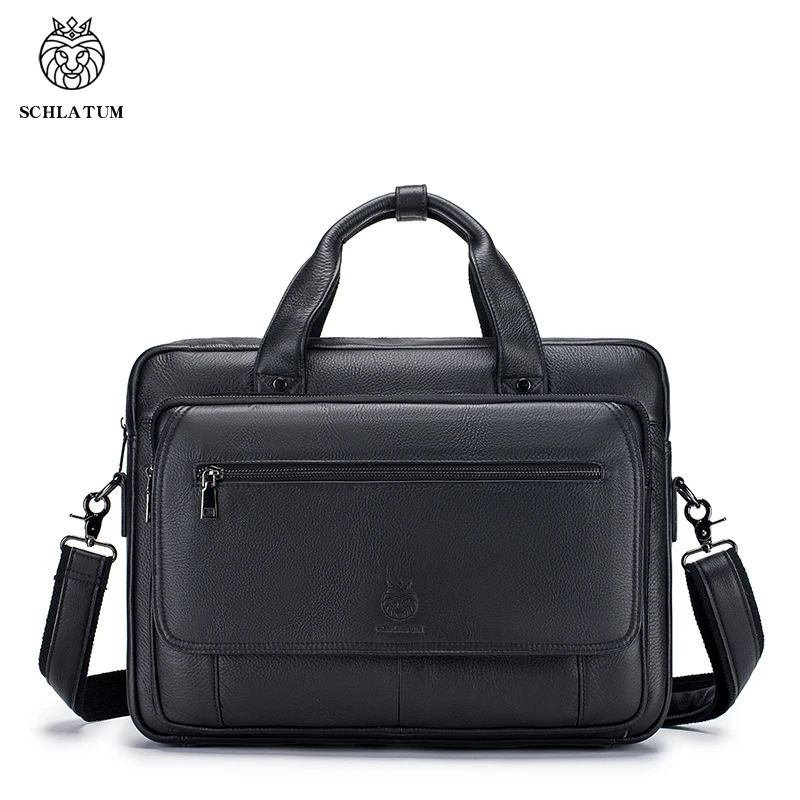
The longevity and functionality of document compartments depend directly on material quality and construction techniques. Superior materials maintain their structural integrity over time, preserving organizational capability through years of professional use.
Understanding the relationship between material selection and organizational performance helps you make informed investment decisions when selecting durable leather briefcase options. This knowledge also guides appropriate care practices that extend functional lifespan.
Key quality indicators for document compartments include:
- Leather grade (full-grain provides maximum durability and character development)
- Stitching density and thread quality (tighter stitching with bonded thread resists failure)
- Edge treatment (rolled or painted edges resist deformation and moisture)
- Reinforcement at stress points (additional material or stitching at corners and folds)
- Hardware quality (solid brass or stainless components resist deformation)
The internal construction deserves particular attention, as these surfaces contact your documents directly. Premium briefcases feature leather-bound edges that prevent lining separation—a common failure point in lower-quality options.
Interior Lining Considerations: Protection From Within
The interior materials that directly contact your documents significantly impact both protection and functionality. These materials must balance protection with practical usability through thousands of document insertions and retrievals.
Common interior lining options include:
- Pigskin: Offers excellent durability and moderate document protection
- Cotton twill: Provides smooth document insertion with good abrasion resistance
- Microsuede: Delivers superior document protection but lower durability
- Synthetic linings: Range widely in quality from superior to problematic
Premium briefcases often feature different lining materials in different compartments, optimizing each section for its specific function. For example, document compartments might feature smooth cotton twill for easy insertion, while electronic compartments use protective microsuede.
When evaluating interior materials, look for tight attachment to the leather exterior without wrinkles or loose sections that can catch on documents during insertion or retrieval.
Care and Maintenance: Preserving Your Briefcase’s Organizational System
Maintaining your briefcase’s organizational capabilities requires specific care practices beyond general leather maintenance. These targeted approaches preserve both aesthetic appearance and functional performance of document compartments.
Regular maintenance prevents common issues that compromise organizational effectiveness:
- Vacuum interior compartments monthly using a narrow attachment to remove dust and debris
- Wipe interior surfaces with a slightly damp cloth quarterly, allowing full drying before closing
- Apply leather conditioner to exterior surfaces twice yearly to prevent dry-rot and cracking
- Inspect and clean closure mechanisms (zippers, clasps, magnets) monthly to ensure proper function
- Store the briefcase upright with light internal support when not in use to maintain compartment shape
These practices are particularly important for commuter bags that face daily environmental exposure and frequent use. Consistent maintenance prevents the gradual degradation that compromises organizational effectiveness over time.
Preventative Measures: Avoiding Organizational Damage
Preventing damage to your briefcase’s organizational system requires awareness of common threats and appropriate protective measures. These preventative practices preserve both function and appearance through years of professional use.
Key preventative measures include:
- Respecting compartment capacity limits rather than overstuffing
- Distributing weight evenly throughout the briefcase structure
- Using document folders for sharp-edged materials to prevent interior damage
- Keeping pens capped and secured in designated holders
- Avoiding placement in extreme temperature conditions that affect leather properties
Pay particular attention to weight distribution, as overloading certain compartments creates stress that permanently deforms internal dividers and support structures. This damage compromises organizational capability even when the briefcase exterior remains attractive.
For maximum longevity, be particularly careful with liquid exposure—even small amounts of moisture can damage interior materials and cause staining that affects both appearance and function.
Conclusion: The Professional Edge of Perfect Organization
The thoughtful organization of your leather briefcase delivers benefits far beyond simple neatness. When your professional materials are perfectly arranged and accessible, you gain tangible advantages in efficiency, presentation, and confidence.
A well-organized briefcase with appropriate document compartments:
- Elevates your professional presence in client and colleague interactions
- Reduces stress during time-sensitive document retrieval situations
- Protects valuable materials from damage during transit and storage
- Creates consistent workflows that enhance overall productivity
- Demonstrates attention to detail that reflects positively on your work
Selecting a briefcase with organizational features aligned to your specific needs represents an investment in both professional effectiveness and personal satisfaction. The right slim leather laptop briefcase becomes a trusted partner in your professional journey, supporting your success through countless meetings, presentations, and workdays.
By applying the principles outlined in this guide—from understanding compartment types to implementing strategic organization systems—you transform a simple leather accessory into a powerful tool for professional excellence. The perfect briefcase doesn’t just carry your documents; it elevates your entire professional experience.

